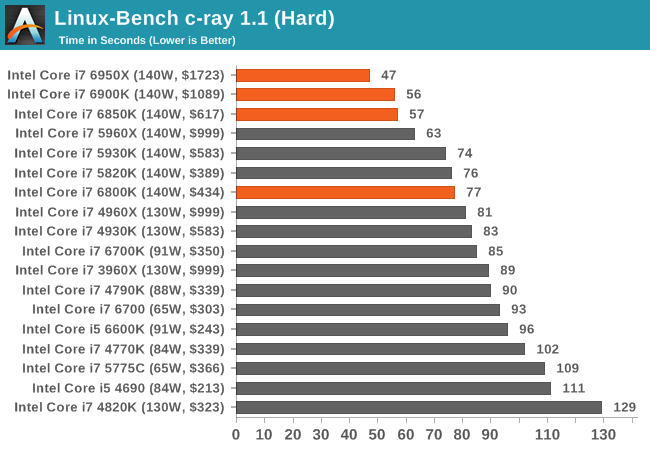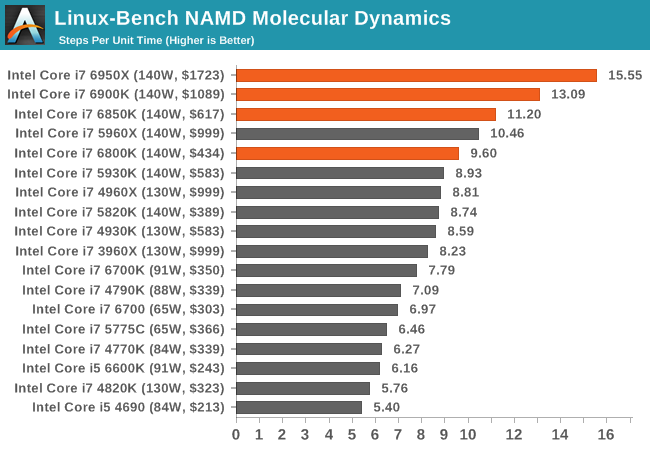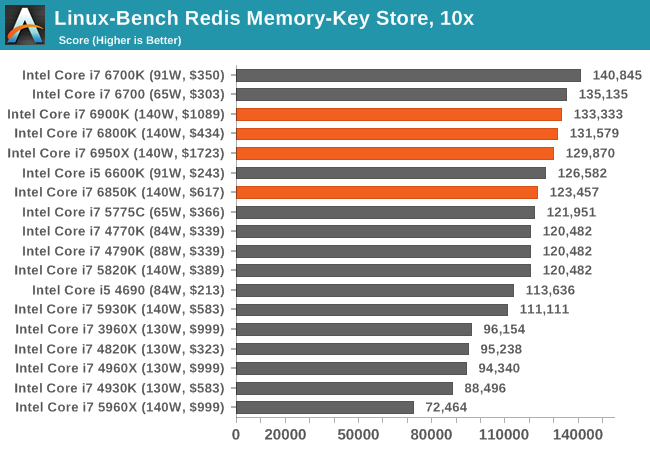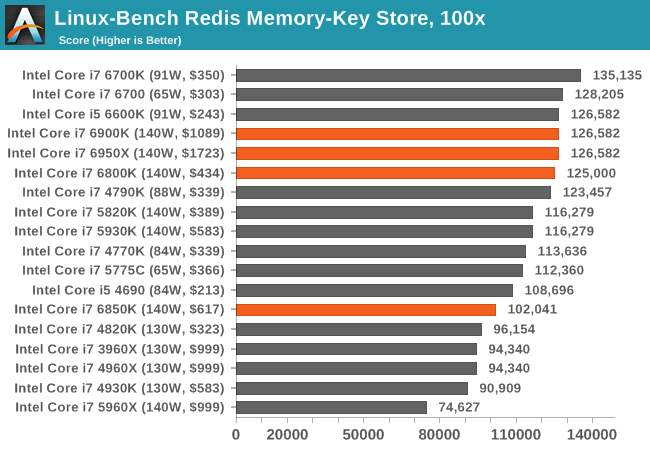The Intel Broadwell-E Review: Core i7-6950X, i7-6900K, i7-6850K and i7-6800K Tested
by Ian Cutress on May 31, 2016 2:01 AM EST- Posted in
- CPUs
- Intel
- Enterprise
- Prosumer
- X99
- 14nm
- Broadwell-E
- HEDT
Linux Performance
Built around several freely available benchmarks for Linux, Linux-Bench is a project spearheaded by Patrick at ServeTheHome to streamline about a dozen of these tests in a single neat package run via a set of three commands using an Ubuntu 11.04 LiveCD. These tests include fluid dynamics used by NASA, ray-tracing, OpenSSL, molecular modeling, and a scalable data structure server for web deployments. We run Linux-Bench and have chosen to report a select few of the tests that rely on CPU and DRAM speed.
C-Ray: link
C-Ray is a simple ray-tracing program that focuses almost exclusively on processor performance rather than DRAM access. The test in Linux-Bench renders a heavy complex scene offering a large scalable scenario.

NAMD, Scalable Molecular Dynamics: link
Developed by the Theoretical and Computational Biophysics Group at the University of Illinois at Urbana-Champaign, NAMD is a set of parallel molecular dynamics codes for extreme parallelization up to and beyond 200,000 cores. The reference paper detailing NAMD has over 4000 citations, and our testing runs a small simulation where the calculation steps per unit time is the output vector.

Redis: link
Many of the online applications rely on key-value caches and data structure servers to operate. Redis is an open-source, scalable web technology with a strong developer base, but also relies heavily on memory bandwidth as well as CPU performance.
[words]












205 Comments
View All Comments
piroroadkill - Tuesday, May 31, 2016 - link
Shitty pricing, lame increases in performance.I really hope Zen lights a fire under their ass.
aggrokalle - Tuesday, May 31, 2016 - link
Hi Ian, is the Intel Thermal Solution TS13A compatible with the thinner package of the Broadwell-E? I didn't find any informations on the intel website. Don't wonna break my shiny new toy :pGodofmosquitos - Tuesday, May 31, 2016 - link
Honestly - as the article itself mentions, the EE-line of CPU's have just fallen too far behind to be considered serious options for enthusiasts. At least imo. I still have a 980X clocked at 4GHz. And it runs everything with stellar performance. That was the last time Intel had an EE-CPU which was ahead of the curve. Also, as PCI-E 4.0 will seemingly require a new platform, due to lacking backwards compatibility of PCI-E 4.0 cards with 3.0 slots, I seriously cannot see anything justifying an upgrade before '18, when PCI-E 4.0 is out, we're on 10nm, and Intel Optane disks are readily available.Godofmosquitos - Tuesday, May 31, 2016 - link
Or well, for "the average" enthusiast at least ^^Impulses - Tuesday, May 31, 2016 - link
What I really don't get is why the 6800K is still saddled with a lower lane count... Aren't the price hikes and the lag to market enough of an HEDT differentiator? Is the lower lane count something that helps yields?They've gone backwards, from having an attractively priced 5820K that could lure some Z170/6700K buyers to basically making HEDT as irrelevant as possible unless you absolutely need the extra cores.
A lot of enthusiasts that don't NEED 6+ cores but COULD benefit from it (photo/video work in the side etc) would be all over a more attractive and less ignored HEDT lineup.
rhysiam - Wednesday, June 1, 2016 - link
I totally agree. I'm due for an upgrade and put myself exactly in that category of photo + video work on the side and being "lured" towards a 5820K. But the price hikes, lag to market and practically 0 performance seems to have pushed the "HEDT" line from enthusiast to niche. Reading this review I don't want anything to do with it.We've waited almost 2 years since the Haswell-E launch and the "update" offers significantly worse price/performance ratios.
Especially with Skylake having plenty of PCIe lanes, with the right motherboard you're covered for 2 graphics cards (or 1 plus a RAID controller), several PCIe SSDs and a 10GBps NIC... plenty for the foreseeable future. Intel is making the cost of these 6+ core CPUs (both in terms of $$s and in the sacrifice you have to make in single threaded performance) larger and larger.
My worry is that pushing up HEDT prices will allow them to bump up the prices of high end mainstream CPUs. Let's see how much the overclockable Kaby Lake i7 costs shall we? I sure hope Zen can shake things up.
adamod - Wednesday, June 1, 2016 - link
market segmentation....no other reasonmapesdhs - Thursday, June 9, 2016 - link
Doubly backwards given the 4820K was a 40-lane chip, whereas the 5820K isn't. It means a 4820K/X79 can do things for gaming with SLI/CF (and still have lanes for storage and other stuff) which a 5820K and 6800K can't.rodmunch69 - Tuesday, May 31, 2016 - link
I had a 980x and then upgraded to a 3930k... 4 years ago. The 2 extra cores were great and useful, but otherwise there wasn't a big difference between the chips. Reading this it doesn't seem like the base 6800k is really much of an upgrade over a 3930k. I've been wanting to upgrade if there was a reason to do so, but Intel again isn't giving me one. One thing however with the 980x is the motherboards and the related chipsets, that's where you'd see a big difference going with something like a 6800k and it would be the reason I'd move off a 980x, but only if I was looking for a reason to move.rodmunch69 - Tuesday, May 31, 2016 - link
I've had a 3930k for 4 years now and I still don't feel much of a need to upgrade. What is going on with Intel? They seriously need a competitor to kick them in the rear and push them ahead.